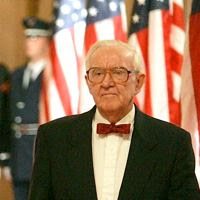Justice Stevens on Targeted Killing
 As detailed via quotes in the post below, the Legal Adviser to the U.S. Department of State, Harold Hongju Koh (below left), [last week] outlined a multi-pronged defense of the Obama Administration's use of drones for targeted killings of presumed al Qaeda operatives. (photo credit) Among the statements made during Koh's keynote speech to the American Society of International Law was this:
As detailed via quotes in the post below, the Legal Adviser to the U.S. Department of State, Harold Hongju Koh (below left), [last week] outlined a multi-pronged defense of the Obama Administration's use of drones for targeted killings of presumed al Qaeda operatives. (photo credit) Among the statements made during Koh's keynote speech to the American Society of International Law was this:
[S]ome have argued that the use of lethal force against specific individuals fails to provide adequate process and thus constitutes unlawful extrajudicial killing. But a state that is engaged in armed conflict or in legitimate self-defense is not required to provide targets with legal process before the state may use lethal force.
One event days before Stevens’s twenty-third birthday would stay with him for the rest of his life. The architect of the Pearl Harbor attack was Admiral Isoroku
Yamamoto, who had learned English from a missionary and become a Babe Ruth fan while studying at Harvard in the 1920s. On April 14, 1943, Americans discovered that Yamamoto [right] was about to travel to the front. Unbeknownst to the Japanese, Stevens explained in an interview more than sixty years later, “We had broken the code.” On Roosevelt’s orders, U.S. pilots downed Yamamoto’s plane over a Solomon Islands jungle on April 18, Easter Sunday. “I was on duty on the day they brought the plane down,” Stevens said, “The message was, ‘We bagged one eagle and two sparrows,’ indicating success in the mission.” The kill buoyed the spirits of many, who knew that getting Yamamoto would, as Stevens put it, “have a tremendous strategic advantage.”
But the incident troubled the young officer. “I remember thinking that the planners must have engaged in a lot of deliberation before deciding to go along with the plan,” Stevens said. “I have read a number of books on it since and discovered that was not the case. They were concerned that targeting him would reveal that they had broken the code.” Accounts of the killing indicate that U.S. Admiral Chester A. Nimitz and others—in communications laced with foxhunting terms—debated only the tactical benefits and costs. “But they had no humanitarian concerns at all of the kind that troubled me,” Stevens said. That fact “kind of surprised me,” he continued, particularly given that Yamamoto “had spent time in the United States and had friendships among high-ranking American officers.”
The morality of military action became a lifelong preoccupation.
Appearing before the Chicago Bar Association decades later, Stevens alluded to the event without naming the target. The Justice told his audience that the experience had sown doubts in his mind about another instance in which the state takes the life of a named individual; that is, capital punishment. Recalling that talk, Stevens affirmed that the Yamamoto incident led him to conclude that “[t]he targeting of a particular individual with the intent to kill him was a lot different than killing a soldier in battle and dealing with a statistic. . . . In my mind, there is a difference between statistics and sitting on a jury and deciding whether to kill a single person.”
That superior officers expressed no qualms in 1943 about targeting Yamamoto suggests earlier sources for Stevens’s “humanitarian” unease.
[Cross-posted from IntLawGrrls]
